NT marine life
The indented coastline of NT with its remote vast mangrove wetlands can be tough to visit, but that is part of the unique experience. Each of NT’s 9 marine bioregions by definition, have a different experiences to offer. These areas are rich in birdlife, turtle nesting sites, fish and inter-tidal fauna. The immense amount of habitat holds large populations of many species, but most are free of many of the pressures normally associated with large human populations.
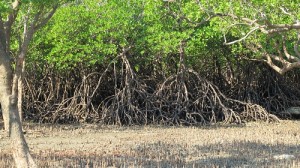
Wetlands
Extensive stands of mangroves are located along the northern coasts of Arnhem Land, in Darwin Harbour and on Bathurst and Melville Islands. NT has about 35% of Australia’s mangrove forests and they are typified by high species diversity, 36 of the 50 species of mangrove can be found in Darwin Harbour. They can be difficult to travel through, insect infested and smelly, but they are very important ecologically. For example, they trap sediments that might otherwise smother Darwin’s large number of small coral reefs. They also support many interesting animals, fruit bats, fiddler crabs, mudskippers, mud crabs, breeding fish and a variety of molluscs. To experience a taste of this wilderness in a low-impact way, board walks with helpful interpretive signs can be found in Darwin.
Turtles and marine mammals
Four species of marine turtle regularly nest in the NT. These are the Flatback Turtle (Natator depressus), Green Turtle (Chelonia mydas), Hawksbill Turtle (Eretmochelys imbricata) and Olive Ridley Turtle (Lepidochelys olivacea). Flatback Turtles are the most widespread nesting species. The range of Green Turtle nesting is restricted to the eastern NT coast. The Green Turtle nesting sites in north eastern Arnhem Land are likely to be of international significance. Bare Sand and Quail Islands near Darwin are the most accessible sites for eco-tour visits.
A significant population of Dugongs exists within the Northern Territory and there is no evidence of a decline in abundance or damage to Dugong habitats. It is the most abundant marine mammal in inshore waters. Entanglement in large mesh (150mm and greater) fishing nets does kill Dugongs, but there is no data on how many are affected. Current estimates put the Australian population at more than 80,000, mostly in north Queensland. In the NT, they are particularly common around the more remote Melville Is, the Coburg Peninsula and the Gulf of Carpentaria. Dugongs, and Snubfin dolphins, are also an occasional sight in Darwin Hbr.
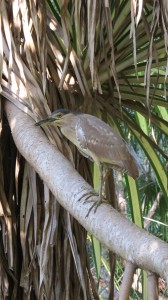
Birdlife
The NT has nationally significant numbers of seabird colonies, and very large numbers of birds. One hundred and forty-seven seabird colonies can be found. Apart from one small colony on the western coast, all colonies are found along the northern and eastern coasts of the Northern Territory from the Tiwi Islands to the Queensland border. The Little Tern, sometimes nest on mainland beaches, but all other colonies are mostly on the smaller islands. The most important areas for colonial seabird breeding were in the area from NE Arnhem Land to Groote Eylandt and the Sir Edward Pellews Islands. The majority of the seabird colonies are located on Aboriginal land. Individual colonies contain between one and five species, and colony sizes vary from single pairs to 60,000 adults. The main species include Silver Gull, Caspian Tern, Lesser Crested Tern, Crested Tern, Roseate Tern, Black-naped Tern, Little Tern, Bridled Tern and the Common Noddy, Although breeding is remote from population centres, large bird numbers mean that they frequently visit centres like Darwin.
Waterfowl and shorebirds in the mangroves and wetlands are very diverse and the more accessible areas support a significant amount of eco-tourism activity. There are many wetland areas that would qualify for Ramsar (or East Asian-Australasian Shorebird Network) status based on shorebird numbers alone. Of particular importance were the wetlands around the Moyle and Finniss Rivers, and between the Adelaide River and Murgenella Creek, the Liverpool/Tomkinson Rivers and the Arafura Swamps and the southern part of Arnhem Bay. Of the resident species, Magpie Goose, all four species of egrets and Australian White Ibis were recorded as the most abundant waterbirds. Other extremely abundant resident waterbird species included Pied Heron, Nankeen Night Heron and Masked Lapwing. There are also large abundances of whistling-duck species, Grey Teal, Glossy and Straw-necked Ibis, Brolga, Black-winged Stilt.
Nationally important populations of Green Pygmy-goose, Great-billed Heron, Black-necked Stork, Osprey, Brahminy Kite, White-bellied Sea Eagle, Chestnut Rail and Comb-crested Jacana are also found.
Underwater life
NT really shines in the fish life department. The impressive shoals of large fish are not as exploited as other metro centres, due to the relatively small human population. Sand Bass Pasammoperca wagiensis and the threadfin pearl perch Glaucosoma magnificum are often seen inshore along with over 400 other varieties including, butterfly cod, sweetlips, greasy cod, batfish, tuskfish and fusiliers.
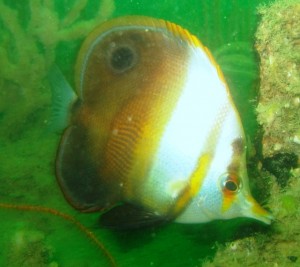
The tropical underwater life in NT is more likely to be shared with the rest of the Indo-Pacific region than is the case in southern waters. It is the overseas holiday that you can have at home. NT waters are also affected by the high tides and heavy sediment loads that are a feature of inshore northern waters.
Much of the seabed along the indented coastline is dominated by gravel, shell grit, or coarse silt. Under the water inshore reef-forming corals are not large due to the lower light penetration. It still has many patches of brain coral (porites) and finger coral (acropora). Honeycomb corals (Favites) are also common and come in a variety of primary colours. Occasional basket corals (Turbinaria) are also found on wrecks and offshore reefs.
The vast tidal movement ensures rich pockets of filter-feeding life, especially on the local wrecks. An array of colourful seawhips, sea fans and soft corals can be found. There are over 40 species of featherstars and a variety of nudibranchs, urchins and sea stars. There are 300 species of sponge, which are not often numerous in tropical waters. Also uncommon in the tropics are the beds of sargassum and caulerpa seaweed that cover the shallow wrecks and reefs.
NT waters contain significant populations of national and internationally threatened species including sawfish, sea snakes, pipefish, seahorses, sharks and rays.
Marine Protected Areas
East Point Aquatic Life Reserve was created in 1993 and was created to protect bottom dwelling life. The reserve permits recreational fishing but bans commercial fishing. This reserve occupies a tiny 365 hectares.
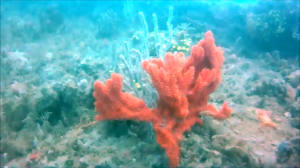
Garig Gunak Barlu National Park,also known as Cobourg Marine Park, was declared in 1983. Unfortunately this park has very few protected marine sanctuary zones. It encompasses approximately 2 990 square kilometres.
The Doctors Gully Aquatic Reservewas created in 1992 and occupies an even tinier 14 hectares. This reserve was created to support a tourism fish feeding venture and is very close to a sewage outlet point. This reserve prohibits commercial and recreational fishing.
Seagrass
Seagrass support fish breeding and are vital to the survival of dugongs and turtles. The seagrass beds directly support the prawn industry which is worth $60 million annually. Seagrass and algae meadows have been rated as the third most valuable ecosystem globally (on per hectare basis), only behind estuaries and flood-plains.
The local seagrass species are those common in the monsoon tropics, Thalassia hemprichii, Enhalus acoroides and Thalassodendron ciliatum in deeper waters. In the intertidal regions Halophila and Halodule species dominate. These quick-growing species are common on mud/sand flats and are the favourite food menu item for dugongs and turtles. Dugong feeding trails can be seen through many of the seagrass beds.
In the NT the seagrass distribution is patchy with large areas of bare silt interspersed with clumps of seagrass. The seagrass will die and sprout in different spots depending on the temperature. Cyclones also cause extensive changes to seagrass beds. In some ways the smaller transient clumps are as important as the bigger beds as dugongs rely on these small dispersed seagrass beds as ‘refuelling stops’ on their migrations.
Crocs and stingers
Everyone visiting the NT worries about saltwater crocodiles and their numbers have been on the rise and they do represent a tangible risk. In the 1970s, incessant hunting had thinned them to an unsustainable number of 3,000 while today the total Australian population is estimated to be around 100,000. In the waters around Darwin, larger crocs tend to be quickly removed by park rangers. They are common in mangroves and in remote estuaries, but rarely encountered around offshore reefs.
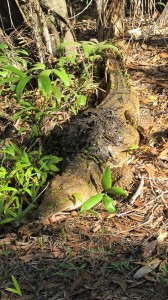
Crocodiles are ambush hunters, and like to lunge out of deeper murky water to catch prey on riverbanks. Don’t stand over deep water, or dangle arms and legs over the boat. Be especially careful during the September to April breeding season, when crocodiles are often more aggressive, territorial, and hungry.
On the plus side, large sharks are not especially prevalent in NT waters, and some of the bigger predatory species found in the south are rarely seen here.
Another concern is the “sea wasp”, or box jellyfish chironex fleckeri, which is particularly prevalent from October to April. They cause extreme pain, even death among the more vulnerable. Irikandji carukia barnesi and Jimbles Carybdea rastoni are also capable of giving very painful stings. Divers and swimmers tend to use thin suits to provide protection from stings. Often mistaken for jellyfish are the swarms of harmless comb jellies that are common in Darwin harbour.
